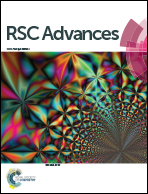Rapid and sensitive detection of acrylic acid using a novel fluorescence assay†
Abstract
We report a fluorescence-based method for the detection of acrylic acid, a high value chemical precursor of acrylate esters and polymers. Our method generates a fluorescent pyrazoline product in the presence of acrylic acid using photoactivated 1,3-dipolar cycloaddition with a diaryltetrazole-based probe, and is capable of detecting, as little as 36 ppb of acrylic acid in vitro and in vivo. We anticipate that this probe will be useful in high throughput screens for biosynthetic production of acrylic acid from biomass and can replace existing chromatographic methods of detection such as GCMS and LCMS, which are low throughput, time-consuming and require sample preparation.



 Please wait while we load your content...
Please wait while we load your content...